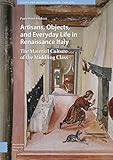Artisans, Objects and Everyday Life in Renaissance Italy : The Material Culture of the Middling Class / Paula Hohti Erichsen.
Material type: TextSeries: Visual and Material Culture, 1300 –1700 ; 21Publisher: Amsterdam : Amsterdam University Press, [2020]Copyright date: ©2020Description: 1 online resource (364 p.)Content type:
TextSeries: Visual and Material Culture, 1300 –1700 ; 21Publisher: Amsterdam : Amsterdam University Press, [2020]Copyright date: ©2020Description: 1 online resource (364 p.)Content type: - 9789048550265
- Artisans -- Italy -- Siena -- History -- 16th century
- Material culture -- Italy -- Siena -- History -- 16th century
- Middle class -- Italy -- Siena -- History -- 16th century
- Art and Material Culture
- Cultural Studies
- History, Art History, and Archaeology
- Sociology and Social History
- ART / History / Renaissance
- Early modern artisans and shopkeepers
- Early modern material culture and daily life
- History of Siena
- Italian Renaissance
- Material culture and consumer history
- Renaissance domestic interior and decorative arts
- online - DeGruyter
| Item type | Current library | Call number | URL | Status | Notes | Barcode | |
|---|---|---|---|---|---|---|---|
 eBook
eBook
|
Biblioteca "Angelicum" Pont. Univ. S.Tommaso d'Aquino Nuvola online | online - DeGruyter (Browse shelf(Opens below)) | Online access | Not for loan (Accesso limitato) | Accesso per gli utenti autorizzati / Access for authorized users | (dgr)9789048550265 |
Frontmatter -- Table of Contents -- Acknowledgements -- Notes on Money, Dates, and Measures -- List of Illustrations -- List of Tables -- Introduction -- Part I ‒ Boundaries and Borders: Artisans and Local Traders in Renaissance Society -- 1. Artisans and Local Traders in Renaissance Siena -- 2. The Economic Status of Sienese Artisans and Shopkeepers -- 3. Boundaries, Borders, and Hierarchies -- Part II ‒ Creative Economies: The Acquisition and Circulation of Material Goods -- 4. Business and Income -- 5. Buying and Acquiring Material Goods -- 6. Dowries and the Circulation of Material Goods -- Part III ‒ The Ownership, Display, and Meanings of Material Goods -- 7. A Respectable and Comfortable Home -- 8. Novelty, Refinement, and ‘Splendour’ -- 9. The Home on Show -- Conclusion -- Appendix -- Glossary -- Bibliography -- About the Author -- Index
restricted access online access with authorization star
http://purl.org/coar/access_right/c_16ec
Did ordinary Italians have a 'Renaissance'? This book presents the first in-depth exploration of how artisans and small local traders experienced the material and cultural Renaissance. Drawing on a rich blend of sixteenth century visual and archival evidence, it examines how individuals and families at artisanal levels (such as shoemakers, barbers, bakers and innkeepers) lived and worked, managed their household economies and consumption, socialised in their homes, and engaged with the arts and the markets for luxury goods. It demonstrates that although the economic and social status of local craftsmen and traders was relatively low, their material possessions show how these men and women who rarely make it into the history books were fully engaged with contemporary culture, cultural customs and the urban way of life.
Mode of access: Internet via World Wide Web.
In English.
Description based on online resource; title from PDF title page (publisher's Web site, viewed 27. Jan 2023)


